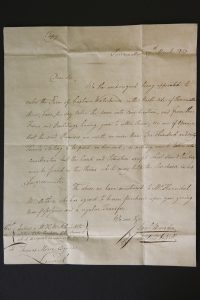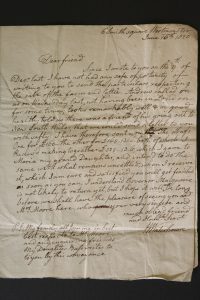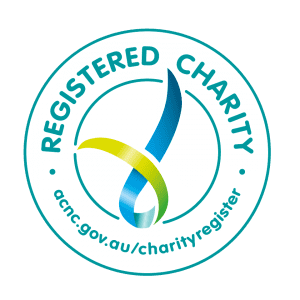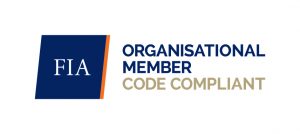Captain Henry Waterhouse was a naval officer, early settler and the first importer of Spanish merino sheep into the colony of New South Wales. He was also a friend and correspondent of Thomas Moore, fellow settler and Moore College’s benefactor.
Recommended for naval service by his father’s employer the Duke of Cumberland, Henry Waterhouse first arrived in the colony with the First Fleet, as a midshipman on Arthur Phillip’s ship Sirius. After returning to England, he came back to Sydney as captain of the Reliance in 1795. The following year he brought back a flock of merino sheep from the Cape of Good Hope, and sold them to John Macarthur, Samuel Marsden and William Cox, among others. He was given two land grants by Governor Hunter and purchased a third property, known as the Vineyard, from the Superintendent of Convicts Philip Schaeffer. He didn’t enjoy colonial life and after some negotiation returned to England in 1800.
The Vineyard was a property in Rydalmere granted to Phillip Schaeffer, a German-born free settler who arrived in 1788 and was appointed Superintendent of Convicts. He built a cottage and planted around 1000 grapevines. He sold this property to Henry Waterhouse in 1797, and his fortunes gradually declined until he died in poverty in 1828 as an inmate of the Benevolent Asylum*.
Waterhouse, living in England at the time, sold the Vineyard in 1813 to Hannibal Hawkins Macarthur, John Macarthur’s nephew. A grand manor house was designed by architect John Verge in the Regency style with Doric columns, and constructed next to the existing cottage. When the property was sold to the Catholic Diocese on behalf of Archbishop Polding in 1849, this house became the Subiaco Benedictine Convent. The nuns lived and worked at Subiaco until 1961 when it was sold to Rheem who demolished the buildings, built factories and continue to use the land for industrial purposes**.
Waterhouse had made Thomas Moore his executor in 1812, giving him the power to sell Waterhouse’s colonial land and livestock. The property at Parramatta fell into disrepair and was described as “having gone to utter ruin” by Samuel Marsden and Rowland Hassall when they made a valuation in 1813.

Henry Waterhouse was a witness at the marriage of his sister to George Bass, and was also a friend of Matthew Flinders. He never married, but had a daughter Maria who was taken to England by Lieutenant Governor Paterson and his wife^. While in England, Waterhouse looked after Thomas Moore’s stepson Andrew Douglas White, who had gone to England in 1795 and enlisted in the Royal Engineers. Andrew’s mother Rachel Turner was a former convict who worked in the household of the First Fleet surgeon John White. Andrew was the only Australian who fought at Waterloo, and after surviving this battle and continuing to serve in the army, returned to Sydney in 1822.

Henry Waterhouse spent his final years trying to trace his brother-in-law George Bass, who had disappeared after setting sail for South America in 1803. Waterhouse died in 1812 and is buried in St John’s, Westminster^.
A full list of the Waterhouse papers can be found on Myrrh. The Samuel Marsden Archives holds 18 documents including letters, the land grant and Waterhouse’s will. The main collection of the Waterhouse family papers as well as the Bass family papers is held by the State Library of NSW.
* ‘Schaffer, Philip (? -1828)’, Australian Dictionary of Biography, National Centre of Biography, Australian National University, http://adb.anu.edu.au/biography/schaffer-philip-2633/text3651, published first in hardcopy 1967, accessed online 31 March 2016. **Anderson, Rebecca. The history of the Vineyard and Subiaco Estate, Rydalmere. 2013. http://arc.parracity.nsw.gov.au/blog/2013/11/09/the-history-of-the-vineyard-and-subiaco-estate-rydalmere/ ^Vivienne Parsons, ‘Waterhouse, Henry (1770 -1812)’, Australian Dictionary of Biography, National Centre of Biography, Australian National University, http://adb.anu.edu.au/biography/waterhouse-henry-2775/text3945, published first in hardcopy 1967, accessed online 30 March 2016.


